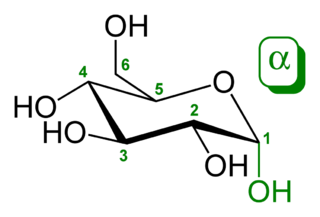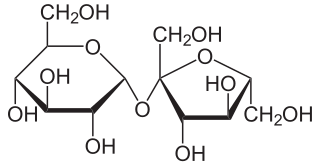
Fructose, or fruit sugar, is a simple ketonic monosaccharide found in many plants, where it is often bonded to glucose to form the disaccharide sucrose. It is one of the three dietary monosaccharides, along with glucose and galactose, that are absorbed directly into blood during digestion. Fructose was discovered by French chemist Augustin-Pierre Dubrunfaut in 1847. The name "fructose" was coined in 1857 by the English chemist William Allen Miller. Pure, dry fructose is a sweet, white, odorless, crystalline solid, and is the most water-soluble of all the sugars. Fructose is found in honey, tree and vine fruits, flowers, berries, and most root vegetables.

Molasses or black treacle is a viscous product resulting from refining sugarcane or sugar beets into sugar. Molasses varies by amount of sugar, method of extraction, and age of plant. Sugarcane molasses is primarily used for sweetening and flavoring foods in the United States, Canada, and elsewhere. Sugar beet molasses is foul-smelling and unpalatable, so it is mostly used as an animal feed additive in Europe and Russia, where it is chiefly produced. Molasses is a defining component of fine commercial brown sugar.

In cooking, a syrup or sirup is a condiment that is a thick, viscous liquid consisting primarily of a solution of sugar in water, containing a large amount of dissolved sugars but showing little tendency to deposit crystals. Its consistency is similar to that of molasses. The viscosity arises from the multiple hydrogen bonds between the dissolved sugar, which has many hydroxyl (OH) groups, anSyrup can be made by dissolving sugar in water or by reducing naturally sweet juices such as cane

Inulins are a group of naturally occurring polysaccharides produced by many types of plants, industrially most often extracted from chicory. The inulins belong to a class of dietary fibers known as fructans. Inulin is used by some plants as a means of storing energy and is typically found in roots or rhizomes. Most plants that synthesize and store inulin do not store other forms of carbohydrate such as starch. In the United States in 2018, the Food and Drug Administration approved inulin as a dietary fiber ingredient used to improve the nutritional value of manufactured food products. Using inulin to measure kidney function is the "gold standard" for comparison with other means of estimating glomerular filtration rate.

Fructose malabsorption, formerly named "dietary fructose intolerance" (DFI), is a digestive disorder in which absorption of fructose is impaired by deficient fructose carriers in the small intestine's enterocytes. This results in an increased concentration of fructose in the entire intestine. Intolerance to fructose was first identified and reported in 1956.

Golden syrup or light treacle is a thick amber-coloured form of inverted sugar syrup made in the process of refining sugar cane or sugar beet juice into sugar, or by treatment of a sugar solution with acid. It is used in a variety of baking recipes and desserts. It has an appearance similar to honey and is often used as a substitute where honey is unavailable or prohibitively expensive. Many vegans also use it as a honey substitute.

Tagatose is a sweetener based on its properties as a monosaccharide, specifically a hexose. It is often found in dairy products, and is very similar in texture to sucrose and is 92% as sweet, but with only 38% of the calories. Tagatose is generally recognized as safe (GRAS) by the FAO/WHO and has been since 2001. Since it is metabolized differently from sucrose, tagatose has a minimal effect on blood glucose and insulin levels. Tagatose is also approved as a tooth-friendly ingredient for dental products.

High-fructose corn syrup (HFCS), also known as glucose-fructose, isoglucose and glucose-fructose syrup, is a sweetener made from corn starch. As in the production of conventional corn syrup, the starch is broken down into glucose by enzymes. To make HFCS, the corn syrup is further processed by glucose isomerase to convert some of its glucose into fructose. HFCS was first marketed in the early 1970s by the Clinton Corn Processing Company, together with the Japanese Agency of Industrial Science and Technology where the enzyme was discovered in 1965.

D-Psicose (D-allulose, D-ribo-2-hexulose, C6H12O6) is a low-energy monosaccharide sugar present in small quantities in natural products. First identified in wheat more than 70 years ago, psicose is a C-3 epimer of D-fructose, and is present in small quantities in agricultural products and commercially prepared carbohydrate complexes. The sweetness of psicose is estimated to be 70% of the sweetness of sucrose. As of 2018, major commercial food or beverage manufacturers use psicose as a sweetener.

Coconut sugar is a palm sugar produced from the sap of the flower bud stem of the coconut palm.
Added sugars are sugar carbohydrates added to food and beverages during their production. This type of sugar is chemically indistinguishable from naturally occurring sugars, but the term "added sugar" has become increasingly used in nutrition and medicine to help identify foods characterized by added energy. Added sugars have no nutritional value, only adding "empty calories". Consumption of added sugar is positively correlated with high calorie intake, and through it, with excess weight and obesity. Added sugars are also known as extrinsic, with naturally occurring sugars known as intrinsic.

































